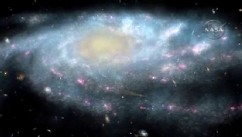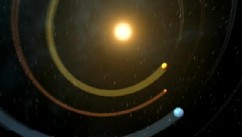
You may look out on a starry night and get a lonely feeling, but astronomers now say our Milky Way galaxy may be thick with planets much like Earth -- perhaps 4.5 billion of them, according to the Harvard-Smithsonian Center for Astrophysics.
Astronomers looked at data from NASA's Kepler space telescope in orbit, and conclude that 6 percent of the red dwarf stars in the Milky Way probably have Earth-like, habitable planets. That's a lot by space standards, and since red dwarfs are very common -- they make up three out of four stars in our part of the galaxy -- we may have a lot more neighbors than we thought.
The nearest of them, astronomers said today, could be 13 light-years away -- not exactly commuting distance, since a light-year is six trillion miles, but a lot closer than most yellow stars like Earth's sun.
Are We Alone in the Universe?Watch Video
NASA Discovers Two Earth-Sized Planets Watch Video
Life in Space: Mars Curiosity RoverWatch Video
"We thought we would have to search vast distances to find an Earth-like planet. Now we realize another Earth is probably in our own backyard, waiting to be spotted," said Courtney Dressing, an astronomer at the Harvard-Smithsonian Center, in announcing the findings today. The results will be published in The Astrophysical Journal.
David Charbonneau, a co-author, said, "We now know the rate of occurrence of habitable planets around the most common stars in our galaxy. That rate implies that it will be significantly easier to search for life beyond the solar system than we previously thought."
Red dwarfs are older, smaller and dimmer than our sun, but a planet orbiting close to one could be sufficiently warmed to have liquid water. Dressing and her colleagues cited three possible planets that were spotted by Kepler, which was launched in 2009. One is 90 percent as large as Earth, and orbits its red sun in just 20 of our days.
There is no saying what such a world would actually be like; the Kepler probe can only show whether distant stars have objects periodically passing in front of them. But based on that, scientists can do some math and estimate the mass and orbit of these possible planets. So far, Kepler has spotted more than 2,700 of them in the small patch of sky it has been watching.
There are estimated to be 200 to 400 billion stars in the Milky Way -- which is probably a pretty average galaxy. So the new estimate implies a universe with tremendous numbers of Earth-like planets, far beyond our ability to count.
Could they be friendly to life? There's no way to know yet, but space scientists say that if you have the right ingredients -- a planet the right size, temperatures that allow for liquid water, organic molecules and so forth -- and the chances may be good, even on a planet that is very different from ours.
"You don't need an Earth clone to have life," said Dressing.
***
Buy land, Mark Twain said. They aren't making any more. Mark Twain didn't reckon with astronomers, who report Wednesday that 6% of red dwarf stars possess ocean-friendly Earth-sized planets.
Space looks a little more crowded, astronomers report. About 6% of nearby dwarf stars likely host Earth-like planets, a science team announced on Wednesday.
The astronomy team at the Harvard-Smithsonian Center for Astrophysics in Cambridge, Mass., says that these "red dwarf" stars, too dim to be seen by the naked eye but by far the most common kind in space, may host many habitable worlds. The finding, based on observations made by NASA's Kepler space telescope, suggests that an Earth-sized world orbiting in its star's "habitable zone" -- not to hot or too cold for oceans -- probably resides within 13 light years of Earth, or about 77 trillion miles. That's neighbors by astronomical standards.
"They're all over the place, there are a lot of red dwarf type stars with planets out there," says astronomer Courtney Dressing, who led the team. Some astronomers call red dwarfs "the vermin of the skies", she notes, because they get in the way when they are trying to study more distant galaxies. "We now have a number and we can say that Earth-sized planets occur fairly frequently around these stars at habitable distances."
The Kepler mission in the last three years has detected some 2,700 potential planets seen in a sample of roughly 145,000 nearby stars out to about 3,000 light years away from Earth. Kepler detects planets by finding the rare ones whose orbital tilt allows them to be seen from Earth as they eclipse, or "transit" in front of their star. In the study, accepted for publication by the Astrophysical Journal, the researchers looked at 3,897 red dwarfs culled from this larger Kepler star sample.
The search turned up three planets that look Earth-sized and orbit their red dwarf stars at a distance warm enough to support oceans, which is seen as a necessity for supporting life as we know it.
Because red dwarfs are dimmer than our sun, their habitable zones are closer to the stars than in our solar system, meaning the newly-discovered planets enjoy "years" lasting from 19 to 56 days. Statistically speaking, their existence means similar Earth-sized worlds likely orbit red dwarf stars even closer to us, says the astronomy team.
"That sounds like a leap but statistically it is a very fair thing to say," says Kepler astronomer Natalie Batalha of NASA's Ames Research Center in Moffett Field, Calif., who was not part of the study. "This really gives us a way forward to look for Earth-sized planets and ultimately to look elsewhere for life."
Over the last decade, astronomers have pointed to a number of these red dwarf stars, less than half the size of the sun, as potential hosts for planets in 'habitable zone' orbits. But the new finds point to statistical support for their relative frequency around red dwarfs. "We thought we would have to search vast distances to find an Earth-like planet," Dressing said. "But they are probably right in our own back yard."



No comments:
Post a Comment